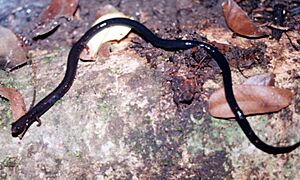Taylor's worm salamander facts for kids
Quick facts for kids Taylor's worm salamander |
|
|---|---|
 |
|
| Conservation status | |
| Scientific classification |
The Taylor's worm salamander (scientific name: Oedipina taylori) is a type of salamander. It belongs to a group of salamanders called the Plethodontidae family. You can find this special salamander in parts of Central America. It lives on the Pacific side of southeastern Guatemala. It also lives in central and northeastern El Salvador, and some areas of southern Honduras. Scientists think that the salamanders in Honduras might actually be a different species.
What's in a Name?
The scientific name for this salamander is taylori. This part of its name is a tribute to a famous American scientist. His name was Edward Harrison Taylor. He lived from 1889 to 1978. Mr. Taylor was a herpetologist, which means he studied reptiles and amphibians like salamanders.
How to Spot a Taylor's Worm Salamander
Scientists first described Oedipina taylori in 1952. This description was made by a scientist named Laurence Cooper Stuart. He studied just one salamander to learn about the species. This first salamander was an adult male. It was about 55 millimeters (about 2.2 inches) long from its snout to its bottom. Its tail was not complete, but scientists believe it would have been much longer. It might have been several times longer than its body!
This salamander has short legs. Its hands and feet are partly webbed, like a duck's foot. This might help it move around. The salamander's body color is a dark, grayish-blue. It looks a bit like another salamander called Oedipina alfaroi. However, the Taylor's worm salamander has less webbing on its toes. It also has fewer vomerine teeth. These are small teeth found in the roof of its mouth.
Where They Live and How They're Doing
The Taylor's worm salamander probably lives in forests. These can be lowland forests or mid-altitude forests. But these salamanders are quite adaptable! They have also been found in places changed by humans. For example, they have been seen in the remains of a broken-down building. They have also been found on a patio in a small town. The very first salamander studied was found under a rotting log. This log was in an open forest area.
These salamanders live at different heights above the sea. They have been found from 140 meters (about 460 feet) up to 1,140 meters (about 3,740 feet) high. This species seems to be able to handle some changes to its habitat. This means they can survive even if their natural homes are a bit changed or damaged.


